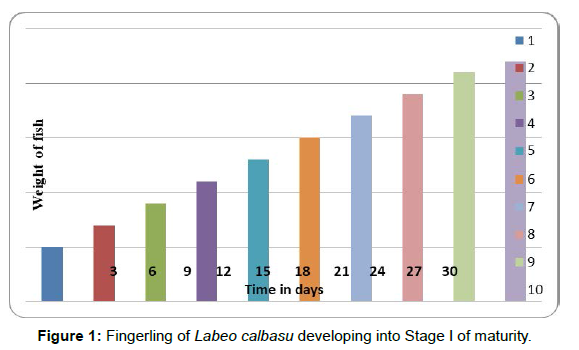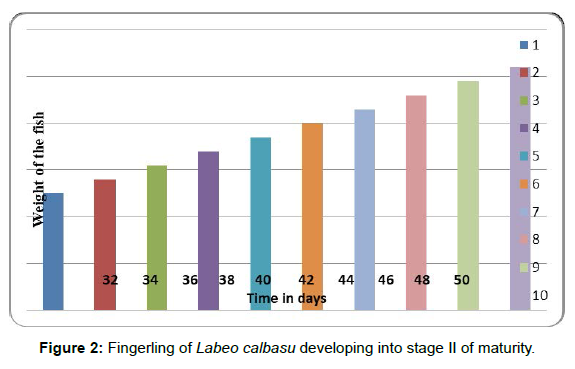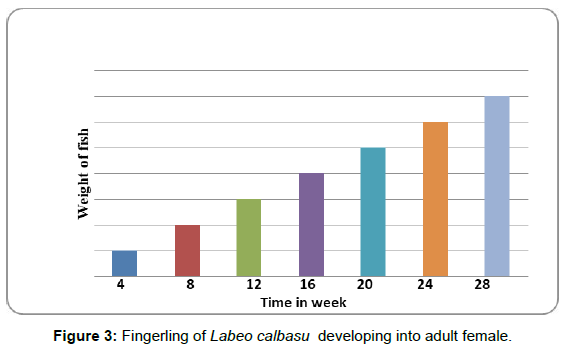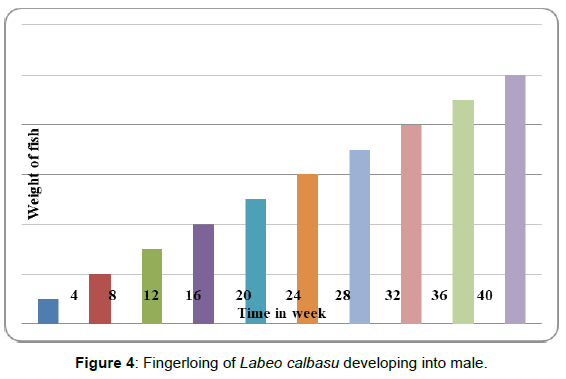Biochemistry Profile & Reproductive Physiology of Economically Important Fish Labeo calbasu of Tripura, India
Received: 01-Jul-2022 / Manuscript No. jflp-22-67474 / Editor assigned: 04-Jul-2022 / PreQC No. jflp-22-67474 (PQ) / Reviewed: 18-Jul-2022 / QC No. jflp-22- 67474 / Revised: 22-Jul-2022 / Manuscript No. jflp-22-67474 (R) / Published Date: 29-Jul-2022 DOI: 10.4172/2332-2608.1000354
Abstract
Being an indigenous carp Labeo calbasu is preferred in the fish market of different corners of India. In the present studies biochemistry profile of the fish species at its different life cycle stages has been found out. The digestive enzyme activity in Labeo calbasu shows the effective role of amylase (1014.0 in activity unit per 100 g fish body weight) and trypsin (62.00 in activity unit per 100 g fish body weight). With examination of faecal matter from its stomach, fore-gut, hind-gut and anus area the fish species shows variation of apparent digestibility coefficient during its fingerling and adult stage as well. Fingerling stage of the fish depicts excretion of 20% protein in the faecal matter while adult stage showing excretion of 40% protein in the faeces. Metabolic faecal protein during the adult stage of the fish amounting 3.6 g/100g of the food consumed. So, the true digestibility coefficient of the protein is about 100% and the amount of food ingested by the adult fish is 100g. Therefore, out of 100% protein availability in the consumed food the metabolic protein has been 3.6 g, digestible protein is 96.4 g while the apparent digestible coefficient is 96.4%. When the adult fish sample is being provided rice powder as feed at different quantities the digestibility coefficient % also found to be varied. When feeding level has been 2 g/fish/day the nutrient composition has been 86.2% protein, 87.66% lipids, 86.78% fibres and 88.12% nitrogen free extracts. Similarly, the digestibility coefficient% varies in relation to the variations of nutrient composition. During experiment on carbohydrate metabolism the adult fish shows presence of 4.28 mg/100g of liver glycogen at control condition. While during treatment with glucagon the liver glycogen decreased to about 3.36 mg/100g. When treated with 3-mercaptopiconilic acid the liver glycogen decreased to about 2.28 mg/100g and further decreased to about 2.26 mg/100g when treated with glucagon and 3-mercaptopiconilic acid.
Keywords: Labeo calbasu; Life cycle stage; Digestibility Coefficient; Glycolysis
Introduction
Knowledge of the biochemistry of fish is important in human nutrition view point. Amongst various fish species carps are considered to be important as nutritious fish for human health. The biochemistry profiles of different carps are although known information of Labeo calbasu is poor in literature [1, 2]. Digestive enzyme activity of many fish species is poorly understood. It varies with fish age, physiological state and seasonal climatic character. For proper growth and development of any fish fauna biochemical profile of digestive enzyme is important [3, 4]. Simultaneously, digestion and absorption of a particular kind food also directly promotes growth rate of a fish at different life cycle stages. So, with apparent digestibility coefficient efficiency of proteinaceous food is understood knowledge of which is poor in literature with regard to many fish species.
The present work communicates biochemistry profile of Labeo calbasu.
Materials and Methods
For experimentation with the studied fish species live fish samples during fingerling and adult stages are being considered. In order to study different biochemical profile of Labeo calbasu the literature of [5] is followed here.
Results and Discussion
Biochemistry
The digestive enzyme activity in Labeo calbasu depicts effective role of amylase (1014.0 in activity unit per 100 g fish body weight) and trypsin (62.00 in activity unit per 100 g fish body weight) during its adult stage (Table 1). [3, 4] pointed out that the amylolytic activity in trout is relatively greater during fingerling stage.
| Enzyme | Activity unit per 100 g fish body weight |
|---|---|
| Amylase | 1014 |
| Trypsin | 62 |
Table 1: Digestive enzyme activity in Labeo calbasu during its adult stage.
During studies of apparent digestibility coefficients of protein by Labeo calbasu at two protein levels and for faeces collected at different areas of the digestive tract the results depict that with the assessment of faecal matter from its stomach, fore-gut, hind-gut and anus area the adult fish species exhibits variation of apparent digestibility coefficient during its fingerling and adult stage as well. Fingerling stage of the fish depicts excretion of 20% protein in the faecal matter while the adult stage showing excretion of 40% protein in the faeces (Table 2). Thus, it indicates that frequent handling of live fish may cause stress development on digestion ability. Similar observations have also been reported by some workers [1, 2, 6, 7].
| Protein level | Faeces collected from different areas of digestive system | |||
|---|---|---|---|---|
| Stomach | Fore gut | Hind gut | Anus | |
| 20% | 61.78 | 64.88 | 74.86 | 81.12 |
| 40% | 61.22 | 74 | 86.24 | 91.62 |
| 60% | 60 | 78.2 | 88.66 | 94.14 |
Table 2: Apparent digestibility coefficients of protein by Labeo calbasu at two protein levels and for faeces collected at different areas of the digestive tract.
Experiments on digestibility coefficient of the protein exhibits that metabolic faecal protein during the pre-adult stage of the fish amounting 3.6 g/100g of the food consumed. Hence, the true digestibility coefficient of the protein has been about 100% and the amount of food ingested by the adult fish is about 100g. Thus, amongst 100% protein availability in the consumed food content the metabolic protein is about 3.6 g, digestible protein is 96.4 g while the apparent digestible coefficient has been 96.4% (Table 3).
| (%) | (g) | (g) | (%) |
|---|---|---|---|
| 100 | 3.6 | 96.4 | 96.4 x 100/100 = 96.4 |
| 50 | 3.6 | 46.4 | 46.4 x 100/50 = 92.8 |
| 20 | 3.6 | 12 | 12.0 x 100/20 = 60.0 |
| 10 | 3.6 | 7.4 | 07.4 x 100/10 = 74.0 |
Table 3: Apparent digestibility coefficient of the protein at pre-adult stage of fish Protein food metabolic protein Digestible protein apparent digestible coefficient.
[1, 2] noticed that the metabolic faecal protein is found to be proportional to the amount of food ingested by the fish. So, the apparent digestibility coefficient of the protein will usually increase with increase in the amount of protein in the food. When the adult fish sample is provided rice powder as feed at different quantities the digestibility coefficient % has also varied accordingly. When feeding level has been 2 g/fish/day the nutrient composition has been 86.2% protein, 87.66% lipids, 86.78 % fibres and 88.12% nitrogen free extracts as well. Similarly, the digestibility coefficient % varies in relation to the variations of feeding level from 4 to 6 g/fish sample/day where nutrient composition also varies accordingly (Table 4). Some workers [8, 1, 2] pointed out that the digestibility coefficient correlates to quantitative variations of food provided to a fish sample.
| Feeding level | Protein | Lipid | Fibres | Nitrogen free extract |
|---|---|---|---|---|
| (G/fish/day) | ||||
| 2 | 86.2 | 87.66 | 86.78 | 88.12 |
| 4 | 80.14 | 84.86 | 88.11 | 78.89 |
| 6 | 88.24 | 93.46 | 94.21 | 93.43 |
Table 4: Digestibility coefficient (%) of rice powder fed by Labeo calbasu at different pre-adult stage of fish.
During experiment on carbohydrate metabolism the adult fish shows presence of 4.28 mg/100g of liver glycogen at control condition. While during treatment with glucagon the liver glycogen decreased to about 3.36 mg/100g. When treated with 3-mercaptopiconilic acid the liver glycogen decreased to about 2.28 mg/100g and further decreased to about 2.26 mg/100g when treated with glucagon and 3-mercaptopiconilic acid (Table 5). The relative importance of glycolysis and gluconeogenesis in providing energy to the fish varies at various physiological conditions. [5] Noticed that in exercised Tilapia mossambicus the level of NH3 excretion relative to oxygen consumption is greater indicating the studied fish generates all of its aerobic energy due to protein catabolism through gluconeogenesis.
| Treatment | Liver glycogen (mg/100 g) |
|---|---|
| At Control condition | 4.28 |
| Glucagon | 3.36 |
| 3-mercaptopiconilic acid | 2.28 |
| Glucagon with 3-mercaptopiconilic acid | 2.26 |
Table 5: Ex- situ studies of glycogen content in the liver of Labeo calbasu during end period of experiment after providing glucagon and 3-mercaptopiconilic acid to the fish sample.
During brood stage of the fish the digestibility coefficient showing metabolic faecal protein increased to about 7.2 g/100g of the food consumed consumed. Thus, amongst 100% available protein in the consumed food content the metabolic protein is about 7.2g, digestible protein is about 140.0 g and the apparent digestible coefficient has also been 140.0% (Table 6).
| Protein food metabolic protein Digestible protein apparent digestible coefficient | |||
| (%) | (g) | (g) | (%) |
|---|---|---|---|
| 100 | 7.2 | 140 | 140.0 x100/100=140.0 |
| 50 | 7.2 | 66 | 66.0 x 100/50 = 132.0 |
| 20 | 7.2 | 24 | 24.0 x 100/20 = 120.0 |
| 10 | 7.2 | 7.8 | 07.8 x 100/10 = 78.0 |
Table 6: Apparent digestibility coefficient of the protein at brood stage of fish.
Therefore, the apparent digestibility coefficient of the protein has been enhanced in the protein of the food material. When the brood fish sample is supplied brown rice powder as feed the digestibility coefficient % has also becomes different (Table 7).
| Feeding level | Protein | Lipid | Fibres | Nitrogen free extract |
|---|---|---|---|---|
| (G/fish/day) | ||||
| 8 | 96.22 | 98.86 | 98.11 | 96.46 |
| 10 | 108.24 | 112.24 | 124.22 | 122.08 |
| 12 | 116.46 | 114.42 | 132.41 | 128.14 |
Table 7: Digestibility coefficient (%) of rice powder fed by Labeo calbasu at brood stage of the fish.
Reproductive physiology
Breeding Season and Maturation: Maturity of the fish species has been observed through examination of gonad. During a period of November to February the studied fish species remains in stage I (Figure 1) and during March it develops into stage II of maturity (Figure 2). The fish samples achieved stage III of maturity during the end of March to beginning of April. A large density of females have been developed into stage IV with matured gonad during the end of March
To about the beginning of April. While a larger density of males also remain in stage IV conditions of maturity. The female fish samples achieved development of matured gonad during a period of April to May. Therefore, the breeding season in this fish species is initiated during late March and continued to early May. Therefore the fingerling stage of Labeo calbasu during the observations developing into adult at a period of 28-30 weeks (Figure 3) while the males developing within a period of 38-40 weeks (Figure 4).
Segregation of brood: During the breeding season from late March to about May the matured adult females from those of adult males are being segregated with morphometric characters of the fish sample. The female brood has been with a weight of 700-800 g while the weight of matured adult males varying from 900-1000 g (Figure 3,4). With certain meristic and morphometric characters the adult fish samples are being differentiated for the purpose of fertilization during captive conditions. Similar observations are also there in the works of many worth mentioning workers [9-20].
Acknowledgement
One of the authors (RB) thankfully acknowledges Head, Department of Molecular Biology & Bioinformatics for providing the experimental facility. Thanks are also due to Professor Mukund Goswami, ICAR-Central Institute of Fisheries Education, Genetics & Biotechnology Division, Deemed University, Versova, Mumbai for inspiration.
References
- Banik S, Kalita R (2021) Biology and biochemistry of some freshwater fish fauna. Unpublished data, Department of Zoology, Tripura University, India.
- Banik S, Kalita R (2021) Biology of some carps of Feni river ecosystem of Tripura, India. Unpublished data, Department of Zoology, Tripura University, India.
- Kitamikado M and S Tachino (1960a) Studies on the digestive enzymes of rainbow trout I Carbohydrates. Bull Japan Soc Sci Fish 26: 679-684.
- Kitamikado M, Tachino S (1960) Studies on the digestive enzymes of rainbow trout II Proteases. Bull Japan Soc Sci Fish 26: 685-690.
- Hepher B (1988) Nutrition of Pond Fishes. Cambridge University Press, Cambridge, USA.
- Smith BW, Lovell RT (1971) Digestibility of nutrients in semi-purified rations by Channel catfish in stainless steel troughs. Proc Ann Conf Southeast Assoc Game Fish Comm 25: 452-459.
- Smith BW, Lovell RT (1973) Determination of apparent protein digestibility in feeds for Channel catfish. Trans American Fish Soc 102: 831-835.
- Bondi A, Spandorf A, Calmi R (1957) The nutritive value of various feeds for carps. Bamidgeh 9: 13-18.
- Abol-Munafi A B, Liem P T, Ambok M A (2006) Effects of maturational hormone treatment on spermatogenesis of hybrid catfish (Clarias macrocephalus x ClariasGariepinus). J Sustain Sci Mang 1: 24-31.
- Adams A, Thompson K D (2006) Biotechnology offers revolution to fish health management. Trends Biotechnol 24: 201-205.
- Adebayo O T, Popoola O M (2008) Storage Period; its effect on efficacy of nonpiscine (frog) Hormone used in inducing ovulation in African Catfish (Clariasgariepinus Burchell, 1822). Int J Zool Res 4: 124-128.
- Afzal M, Rab A, Akhtar N, Khan M F, Khan S U et al. (2008) Induced spawning of bighead carp, Aristichthys nobilis (Richardson) by using different hormones/hormonal analogues. Pakistan J Zool 40: 283-287.
- Agarwal N K, Thapliyal B L, Raghuvanshi SK (2007) Induced breeding and artificial fertilization of Snow trout, Schizothoraxrichordsoni through the application of ova prim. J Inland Fish Soc India 39: 12-19.
- Akhteruzzaman M, Kohinoor AHM, Shah MS (1992) Observations on the induced breeding of Puntius sarana (Hamilton). Bangladesh J Zool 20: 291-295.
- Akhteruzzaman M, Kohinoor AHM ,Shah MS, Hussain M G (1993) Observation on the induced breeding of silurid catfish, Ompokpabda (Hamilton). Bangladesh J Life Sci 5: 71-75.
- Alikunhi K H, Sukumaran KK, Parameswaran S, Banerjee S C (1964) Preliminary observations on commercial breeding of Indian carps under controlled temperature in the laboratory. Bull Cent Ind Fish Res Inst Barrackpore 3: 20-22.
- Alikunhi K H, Sukumaran K K, Parameswaran S (1963) Induced spawning of Chinese carps Ctenopharyngodonidellus (C. & V.) and Hypophthalichthys molitrix (C. & V.) in ponds at Cuttack, India. Curr Sci 32: 103-126.
- Alikunhi K H, Vijayalakshmanan M A, Ibrahim K H (1960) “Preliminary observations on the spawning of Indian carps induced by injection of pituitary hormones, Indian. J Fish 7: 1–19.
- Alikunhi K H, Sukumaran K K, Banerjee S C (1964) Preliminary observation on commercial breeding of Indian Carps under controlled temperature in laboratory. Bull No 3 Barrackpore, India: Cent Inland Fish Res Insti.
- Ali M Y (1997) Induced breeding of major carps in ponds by pituitary hormone injection, Agricultural Information Service, Dhaka, Bangladesh.
Indexed at Google Scholar, Crossref
Citation: Banik R, Bhattacharjee S, Bhowmik MK (2022) Biochemistry Profile & Reproductive Physiology of Economically Important Fish Labeo calbasu of Tripura, India. J Fisheries Livest Prod 10: 354. DOI: 10.4172/2332-2608.1000354
Copyright: © 2022 Banik R. This is an open-access article distributed under the terms of the Creative Commons Attribution License, which permits unrestricted use, distribution, and reproduction in any medium, provided the original author and source are credited.
Share This Article
Recommended Journals
Open Access Journals
Article Tools
Article Usage
- Total views: 1696
- [From(publication date): 0-2022 - Mar 29, 2025]
- Breakdown by view type
- HTML page views: 1351
- PDF downloads: 345




